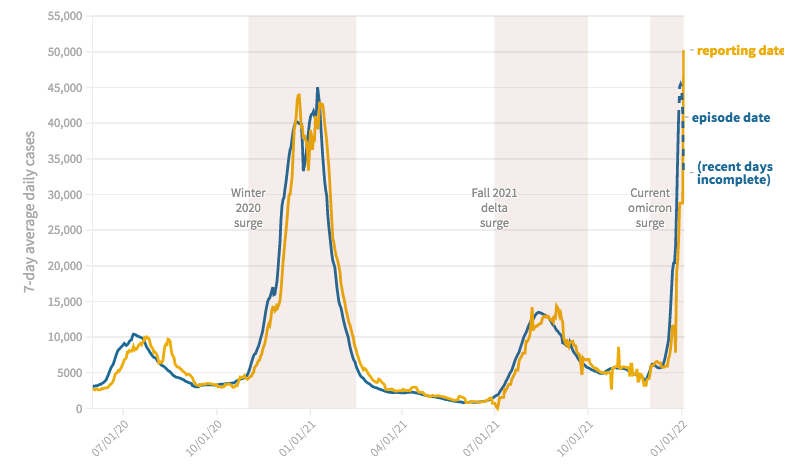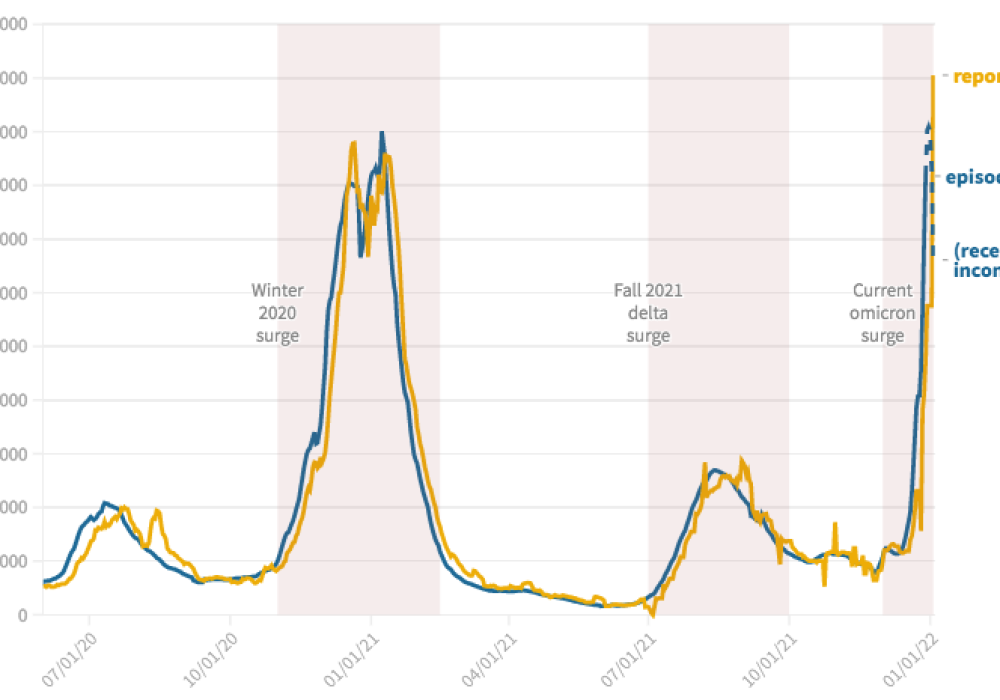The numbers from the holiday weekend are in — and California has broken every record for new coronavirus cases. Obliterated them, actually.
The California Department of Public Health, which had a long holiday weekend with no new data, reported more than 230,000 new cases on Tuesday, more than twice as many as has been reported in a single day before. The holiday data dump brings the 7-day average of new daily cases to a new record high of 45,466 daily cases — nearly doubling from the data available the day before. That figure appears poised to soar past 50,000 average daily cases as new data is confirmed.
In highly vaccinated San Francisco, 829 people are testing positive on average each day, more than double last winter’s peak, and there are more than 95 COVID-19 cases per 100,000 people in the city.
“We believe that the height of this surge is upon us,” the city’s health director, Grant Colfax, said during a virtual press conference Tuesday.
But Colfax and other San Francisco officials said the current omicron surge is different from previous waves, in large part because most residents are vaccinated and boosted, so they are well protected against severe illness, hospitalization and death. Right now, Colfax said, as many as 30% of patients with COVID-19 at Zuckerberg San Francisco General Hospital were found to be positive after arriving for other reasons.
“We’re in a much different place,” said Mayor London Breed. “Right now, we’re learning what it means to live with COVID.”
“The consequences today are not catastrophic” for vaccinated residents, Breed said. “That’s a stark contrast to the impact COVID had before the vaccines.”
Colfax said the city currently has enough hospital beds to manage the surge, but he and others are concerned about health care workers and other frontline workers like police, bus drivers and firefighters getting sick. San Francisco canceled its traditional New Year’s Eve fireworks show in part because of staffing issues, and the city, Breed said, is seeing some missed runs on Muni lines, making for longer wait times, although all routes are still running. Testing kits for first responders and other frontline workers have also been hard to come by, and officials acknowledged demand for testing is skyrocketing.
Breed urged private health providers to “do their part” and make testing available for the people they insure, to free up city testing resources for others.
But, Breed said, “we’re not shutting anything down…This is not 2020.”
Still, some places are making significant changes. FCI Dublin, a low-security federal correctional institution in Alameda County, has suspended all visits. In Santa Clara County, Stanford on Tuesday said it would limit spectators at indoor sporting events to student-athlete families. Spectators seated at outdoor events will be socially distanced and must wear a mask. San Mateo County said Monday it would delay jury trials.
The Golden State is catching up to COVID hotspots in other parts of the country that had already toppled last winter’s peak for new infections. The 7-day average of new daily cases in the U.S. as a whole surpassed 400,000 this week for the first time. The previous record was 251,000 just under a year ago.
The unprecedented surge in cases has also fueled a sharp rise in hospitalizations.
The number of patients in California hospitals who are COVID positive has increased more rapidly in the past 10 days than at any other point in the pandemic, though the percent of positive cases needing hospitalizations is lower than before.
Case rates in California have been on a steep rise since mid-December, just two weeks after the first case of the extra-contagious omicron variant was identified in the state. But amid surging cases, the data show vaccinations provide some protection against infection, and even greater protection from hospitalization and death. And boosters seem to provide a marked improvement in protection, based on data from one Bay Area county. But even the protection from boosters isn’t preventing breakthrough case rates from also skyrocketing.
A closer look at data provided by the Contra Costa County health department reveals another startling finding about how omicron is more contagious its predecessors. Breakthrough case rates there for vaccinated but un-boosted residents have just surpassed the case rate for the unvaccinated during this past summer’s delta surge. To be sure, unvaccinated residents are still more likely to become infected with omicron than vaccinated ones, and boosters provide even more protection, the data show.
The case rate for unvaccinated residents was about 50 per 100,000 residents per day, as of Dec. 25, the most recent day for which data is reliably complete. Residents who are vaccinated but have not received a booster had a case rate of 33, but boosted residents have a case rate of 15, less than half of their un-boosted neighbors and a quarter the rate among the unvaccinated.
Check back for more on this developing story.










